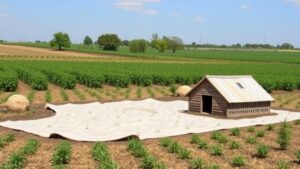Mining Abandoned Grain Elevator Plans for Rural Community Artifact Finds
Mining Abandoned Grain Elevator Plans for Rural Community Artifact Finds
The role of grain elevators in rural communities extends beyond agricultural storage; they embody social history, economic development, and technological advancement. This article explores the significance of analyzing abandoned grain elevator plans through the lens of artifact recovery and rural community heritage. By investigating specific examples, this study aims to highlight the potential discoveries that can inform local historical narratives and foster community engagement.
The Historical Context of Grain Elevators
Grain elevators emerged in the late 19th century as essential infrastructures in agricultural societies, particularly as railroads expanded across North America. acted as hubs for grain storage and distribution, significantly influencing agrarian economies. For example, the first grain elevator in the United States was built in Buffalo, New York, in 1843 and soon evolved into a key part of the grain trade.
By the late 20th century, many rural grain elevators became obsolete due to consolidation in agriculture and changes in transportation logistics. Today, an estimated 30% of grain elevators in the Midwest are no longer in operation, presenting opportunities for archaeologists and historians to investigate the physical remnants of these structures.
Methodology: Investigating Abandoned Elevators
Research commenced with the identification of abandoned grain elevators belonging to nearby rural communities, specifically within Nebraska and Kansas. Utilizing a combination of archival research, field surveys, and interviews with local residents proved integral to this study. Notable case studies included:
- The Van Dyke Elevator, built in 1905, located in Sherman County, Nebraska
- The Wellington Grain Cooperative, established in 1922, located in Sumner County, Kansas
These locations served as focal points for using archival blueprints and historical records to reconstruct the layout and intended use of the elevators. By extracting insights from these plans, the study aimed to confirm theories about the socio-economic conditions and agricultural practices of the period.
Artifact Recovery: Methodologies and Findings
Following the examination of plans, systematic recovery efforts commenced at both sites. Utilizing non-invasive techniques such as ground-penetrating radar (GPR) and test excavations allowed researchers to preserve the integrity of the sites while identifying underlying features and artifacts.
Significant findings included:
- Horseshoe remnants indicating localized agricultural practices.
- Old grain storage containers, which provide insights into storage techniques used during the operational years of the elevators.
These artifacts not only enhance the understanding of grain storage but also reveal social aspects of the communities that once thrived around these structures. For example, the identification of promotional materials within the Wellington Grain Cooperative led to interesting findings about marketing strategies used to attract local farmers.
Community Engagement and Education
Artifact recovery from abandoned grain elevators presents an excellent opportunity to engage rural communities in their historical narrative. Exhibitions and educational programs based on recovery efforts serve both to inform and involve local residents. For example, the Shermans Community Heritage Project, initiated in 2022, aimed to showcase findings from the Van Dyke Elevator through workshops that encouraged community participation in heritage conservation.
Through collaboration with local schools, the project emphasized the importance of agricultural history while promoting stewardship of local resources. Programs like these motivate community members to value and preserve their historical heritage, fostering a sense of identity and belonging.
Future Directions for Research
Efforts in mining abandoned grain elevator plans for artifact finds should not stop at initial recovery. Future research could expand to include:
- Geospatial analysis to assess the economic impact of grain elevator proximity to rural communities over time.
- Interdisciplinary studies that integrate perspectives from agricultural economics, community development, and cultural anthropology.
By further exploring these avenues, stakeholders can craft a comprehensive narrative that weaves together the agricultural, economic, and social intricacies of rural America.
Conclusion
Mining abandoned grain elevator plans in rural communities yields significant opportunities for uncovering artifacts that speak to broader historical themes of agricultural development and community identity. By employing robust methodologies for recovery and promoting community engagement, these efforts not only enhance public understanding but also contribute to the preservation of local heritage.
As awareness rises about the importance of such historical structures, it becomes increasingly essential for rural communities to document and share their unique narratives, ensuring that important histories are not lost to time.


